This was published 8 years ago
Satellite Island, Tasmania, Australia: The Tassie island perfect for seafood lovers
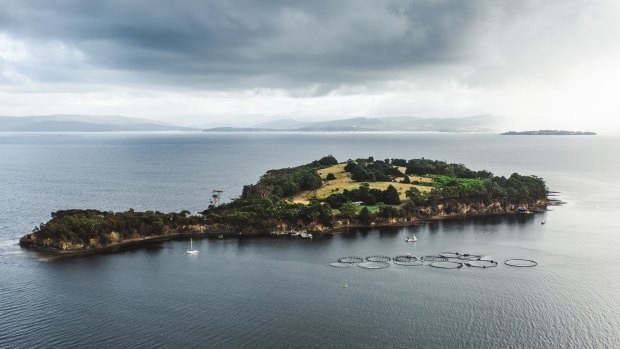
Satellite Island Tasmania.Credit: Adam Gibson
The official welcoming party was as follows: One bucket of Pacific oysters. One southern rock lobster. Bert and Henry the stags, Rodney the rooster. Two Buff Sussex chickens. Six ISA Browns. Ten guinea fowl. One ram's skull hanging beside the front door.
The black-faced sheep and the abalone and the sea urchin came later.
But first, a briefing from owner Kate: the 34-hectare Satellite Island would be ours alone for the next two days, aside from the presence of manager, Richard Roe, who lives a few hundred metres from the house and would keep a low profile unless called upon.
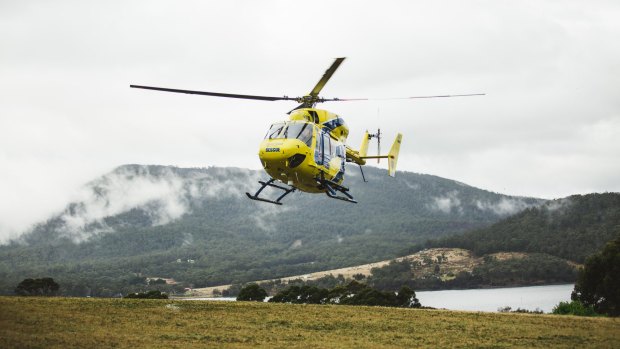
Guests arrive in style.Credit: Satellite Island
Only recently had the private island been opened to paying guests, said Kate, who soon enough would zip away across the water. We could choose our sleeping quarters — the jetty's boathouse, at water's level and edge, or the summer house, 54 steep steps up the hill.
There were, said Kate, leading us to a refrigerator in the summer house, a few things we needed to be aware of. Could we shuck oysters? If not, Roe would wield the knife. The bucket was a battered old metal thing, the oysters gnarly and wild, carved from the island's rocks that morning. The southern rock lobster was large and somnolent in a box, limbs moving languidly. The Woodbridge Smokehouse trout (from the Tasmanian mainland) would be fine indeed, Kate suggested, with the sourdough we had brought with us from Hobart's Daci & Daci Bakers.
For enthusiasts, there was a fine collection of knives in the kitchen, including a set from 1803 Artisan Deer Design, exquisite things, hand-forged in the Huon Valley, set in deer antler handles, some trimmed with silver or brass. The pots of herbs were lush and only a little hen-pecked; the eggs in the kitchen had been plucked that morning from the chook house, the petite pink lady apples from a Bruny Island tree.
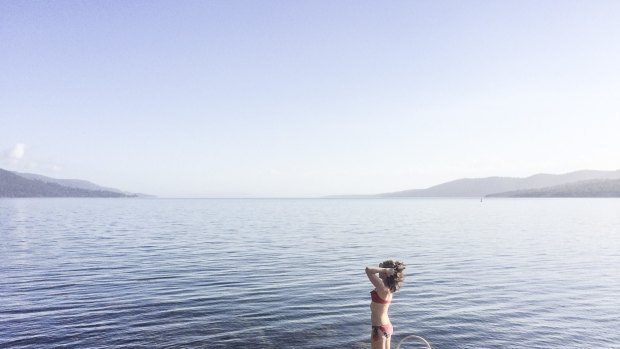
Time for a swim.Credit: Mark Chew
Satellite Island, which, seen as a shape on a map, suggests a whale with an inadequate, limp tail, lies in the D'entrecasteaux Channel between the Tasmanian mainland and Bruny Island. In terms of time, the figures are modest: a 30-minute drive from Hobart (to the car ferry at Kettering); a breezy 15-minute ferry ride to Bruny Island; a 40-minute drive south from the ferry terminal to the hamlet of Alonnah; and then, a five-minute, wind-torn dash in Roe's speedboat to Satellite.
In terms of mental passage though, no calculation is possible. Here, seemingly within hollering distance of Mawson's Hut, time is relevant only insofar as it slips away too quickly. The silence is acute. The air is piercing in its clarity; a nudge to some primordial memory. The fires — a stove in the Summer House and a cypress-pine-filled fire pit on the jetty where pristine Southern Ocean waters lap — are hypnotic.
Aborigines lived alongside these waters for millennia; there are significant Aboriginal sites on Bruny Island, middens, quarries and stone arrangements. And then came the mariners: Abel Tasman, James Cook, William Bligh and Matthew Flinders all sailed close as they navigated the wild seas to the south of what Tasman named Van Diemen's Land.
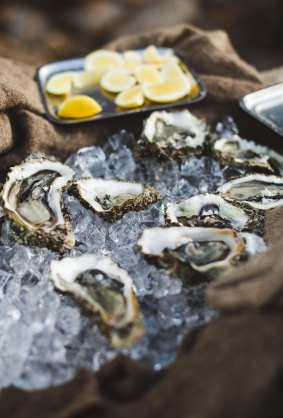
Fresh oysters.Credit: Adam Gibson
"At each step we met here the beauties of that nature abandoned to herself," wrote the French mariner Bruny D'Entrecasteaux of the world he discovered in the channel that today bears his name. It is that nature abandoned that lured the original owner to Satellite Island in the 1960s.
After he bought the island, he built a simple house on the hill. He farmed sheep, started a salmon farm and wrote and painted. Kate's family took over the island when her husband's uncle died.
The original three-bedroom home is still simple but stylish, slicked with fresh grey and white paint tones and decorated in a manner that might be seen on some Scandinavian designer's Instagram account: timber floorboards, English ladder-back carver chairs draped with Finnish reindeer hides, wood-burning stove, generous lounges, Sisal rugs, piles of books, and random rustic ornamentation — a driftwood and oyster-shell mobile, deer horns, lobster pots.
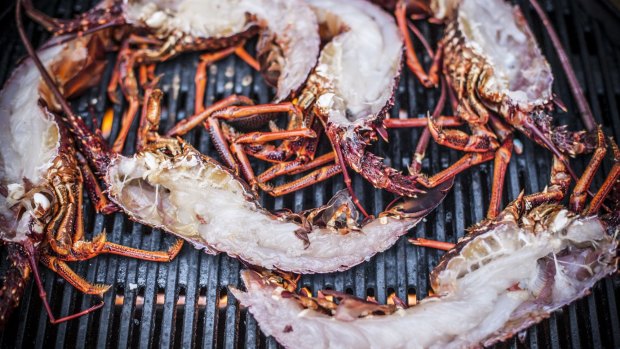
Dinner on the island.Credit: Mark Chew
And, all the while, as you admire the interior, the exterior is thrusting itself forward, demanding attention like some petulant child. "Look at me, look at me!" And you look and it's blue and green, the sea in every direction, backdropped by the forested hills of Bruny Island and the Tasmanian mainland.
On our first night in residence, as dusk descends and blue-green fades to black, the way forward is clear: the fire in the Summer House stove must be built, the long wooden table must be set with linen and old Norwegian crystal glasses from the antique pine dresser, oysters must be shucked, a lobster must be barbecued.
These oysters are rugged and obstinate but the eating of these voluptuous things, unsullied by civilisation, is easy. Then the lobster succumbs to the heat of the barbecue and a buttery, garlicky, lemony sauce. We feast by candlelight, drink Tasmanian wines we've brought with us from Hobart and finish with cheeses from Bruny Island Cheese, including the wonderful "1792", a soft washed rind set on a Huon pine board.
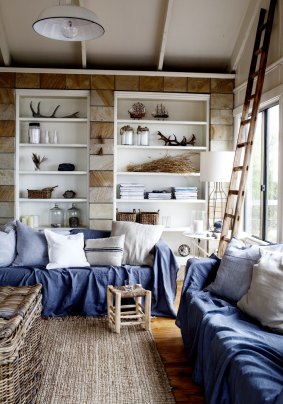
Accommodation is cosy.Credit: Mark Chew
In the morning, we have knock-kneed, antlered visitors: the stags Bert and Henry. They're inquisitive — and hungry. They know there are apples kept for them in a bucket on the Summer House deck. As they inch forward to take our offerings, they're jittery and skittish. Still, when Kate visits the island, they sometimes follow her like puppies.
There are 60 fallow deer on the island, which are farmed for venison, and a handful of Hampshire Downs sheep, but on a morning walk around the island it becomes clear they have none of Bert and Henry's chutzpah; as we cross country through bluegums, sheoaks and casuarina, the deer flee. At "Gunwhale Point" on the blustery south-west tip of the island, the sheep resist our friendly advances.
Kate's favourite walk is to the island's peak. "We often have lunch up there; it just makes me take a deep breath; you get this expanse in front of you ... the mountains, the cliffs, the trees virtually tumbling down to the sea." A pair of white-breasted sea eagles might show off in the sky while, in December and January, the offspring of Pacific gulls make a playground of the rock shelf circling the island. Satellite's rock shelf walk is an essential activity, best done at low tide. Fossils are embedded in the cliff faces while the rock pools are a coast-comber's delight, alive with anemones, sea snails, pinky, palm-sized crabs and drifting emerald seaweeds.
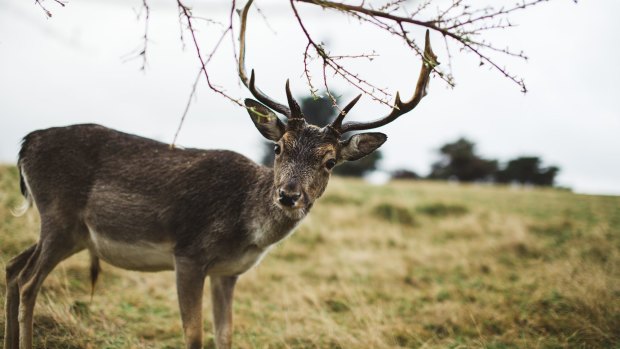
The island has 60 fallow deer.Credit: Adam Gibson
Towards the end of our walk, above "Morning Light Bay", we watch the sea and momentarily imagine a seal is frolicking in the shallows. But the dark shape that lifts its head from the water proves to be human: it is Roe in wetsuit, flippers and mask. A little later, back at the Summer House, a frogmannish figure pads dripping across the lawn towards the house carrying a net bag holding a monstrous, weed-covered abalone and a clutch of sea urchins. An unexpected dinner has arrived.
First though, time must be spent down at the boathouse, a photogenic wonder that has been used as a backdrop for fashion shoots. We drag deck chairs to the edge of the jetty, cast a line and settle in with a glass of wine. There's one teasing tug on the line but, whatever life form it might be, it becomes the one that got away.
It's autumn and these southern waters are frigid but the challenge has to be faced: we plunge crazily into the sea and in seconds are clambering back on to the jetty, laughing and gasping and grabbing for warmth.
As the afternoon folds in on itself, we cocoon ourselves in the boathouse and watch the colours outside shift through a spectrum of blue-greens over rocky, oyster shelled bottom, kelp forests and deep water. The sky dims, the grey-tinged clouds against blue sky blur, the crests of the mainland backdrop darken.
Hunger drives us back up the steps to the summer house kitchen. We flash fry the abalone in butter and garlic, tackle the spiny urchin exteriors to extract the rich roe, and turn the remaining oysters into a soup.
And then, the boathouse again exerts its magnetic force. Back at water level, we light the cypress-heaped fire pit and sleep with the doors open, fire crackling, chill air on our cheeks, southern waters lapping beneath us.
TRIP NOTES
MORE INFORMATION
GETTING THERE
Virgin Australia, Qantas, Jetstar and Tiger Airways fly to Hobart. All major car hire companies have desks at Hobart Airport. Satellite Island is a five-minute boat ride from Bruny Island hamlet of Alonnah which is a 40-minute drive from the Bruny Island ferry terminal. Manager Richard Roe meets visitors at Alonnah and transports them to the island by boat. The car ferry to Bruny Island at Kettering is a 30-minute drive from Hobart. See www.qantas.com; www.virginstar.com; www.tigerair.com
STAYING THERE
Satellite Island sleeps a maximum of 12 people. The Summer House sleeps six in three bedrooms including a king-sized main. The boathouse has two bedrooms, each with a king-sized bed. Bunks can be provided instead. Rates for hiring the entire island begin at $1050 per night for a couple. Accommodation is for a minimum of two nights off-peak and five nights in peak season (Dec-Jan and Easter school holidays).
SEE+DO
Walk around the island or on the rock shelf platform at water's edge; ask Roe to take you back to Bruny Island for explorations there. Board games, sports equipment, kayaks, snorkels, flippers and masks are provided.
DINING THERE
Guests can stock up at outlets including Bruny Island Cheese on their way to the island. Oysters, a bottle of Tasmanian sparkling and fresh eggs await guests on arrival. A new vegetable garden will be ready in spring and guests will be welcome to use its produce. Fishing rods and bait are provided. A chef can be arranged to cater for guests, or Roe will organise for the house to be stocked with produce such as crayfish and other Bruny Island specialities.
The writer was a guest of Satellite Island.
Sign up for the Traveller Deals newsletter
Get exclusive travel deals delivered straight to your inbox. Sign up now.